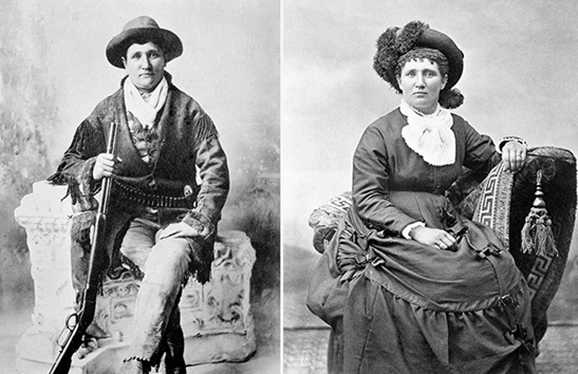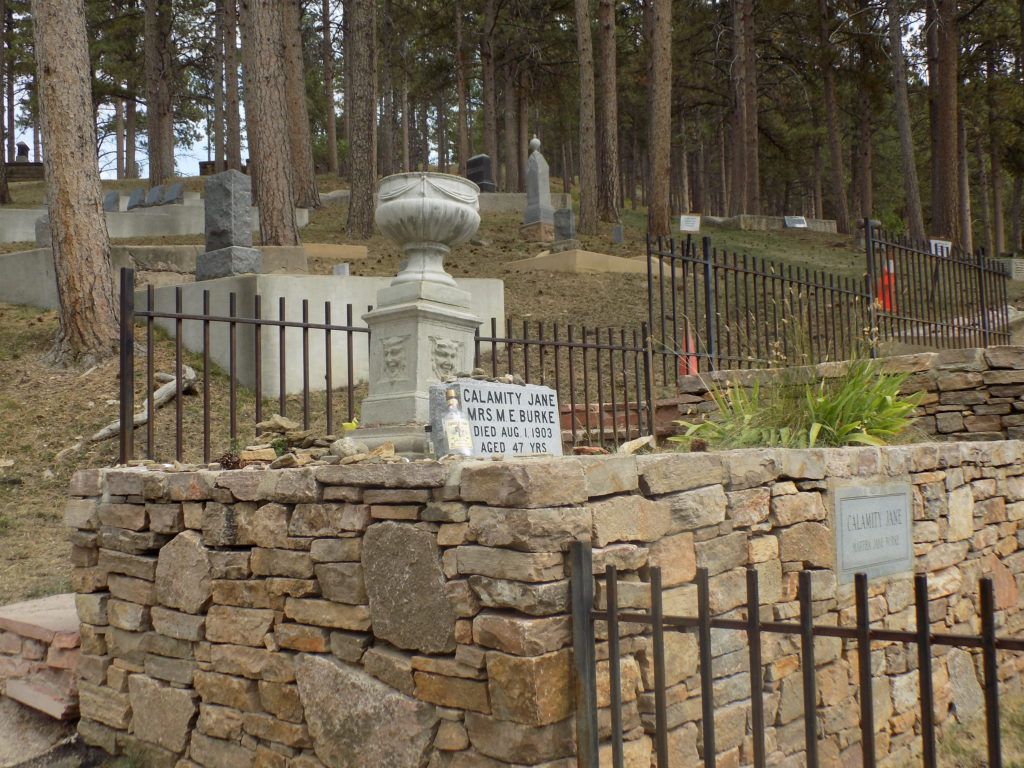Martha Jane Cannary (or Canary).
Born in Princeton, Missouri on 1 May 1852, the eldest of six children, Martha Jane Cannary would etch a slightly different name into the annals of the American west – that of Calamity Jane. Martha’s father Robert moved the family by wagon train to Virginia City, Montana in 1865 and during the transit, the teenage Martha spent much of her time hunting with the men and, it was said, she became an excellent shot and fearless rider. In 1866, some short time after the family reached Montana, Martha’s mother died in the town of Blackfoot and her father then moved the family from Montana to Salt Lake City.
Within a year (or possibly less) Robert also died leaving 14-year-old Martha in charge of her five younger siblings. Apparently unconvinced that travel wasn’t the best course of action for the Cannary family, Martha led her charges first by wagon to Fort Bridger and then by rail to Piedmont, Wyoming. Once in Piedmont, Martha was industrious and resourceful in trying to provide for her family. She worked as a cook, a nurse, a dance-hall girl, a dishwasher, a waitress, an ox-team driver, and according to some, a prostitute.
It’s unclear how long Martha stayed with her family in Piedmont but it seems clear that even as early as 1871 or 1872 when the first references to Calamity Jane began to appear in local newspapers whose editors where hungry for sensationalized stories to sell their publications, she had developed a persona that was gaining local notoriety.
[Photo of Calamity Jane from Oregon Quarterly.]
By 1875 or so, newspapers in places such as Chicago and Minneapolis began publishing stories about the adventures of Calamity Jane. Then, in 1877 Edward Wheeler published the first of his “Deadwood Dick” series of dime novels with Calamity Jane as a featured character. Wheeler’s prolonged publication of this series of fictionalized accounts of the wild west over two decades inadvertently or deliberately cemented Jane’s public image.
Never one to shy away from shaping that image, Martha Jane published an autobiographical pamphlet titled Life and Adventures of Calamity Jane, By Herself in which she recounts the story behind her name,
It was during this campaign [in 1872–73] that I was christened Calamity Jane. It was on Goose Creek, Wyoming where the town of Sheridan is now located. Capt. Egan was in command of the Post. We were ordered out to quell an uprising of the Indians, and were out for several days, had numerous skirmishes during which six of the soldiers were killed and several severely wounded. When on returning to the Post we were ambushed about a mile and a half from our destination. When fired upon Capt. Egan was shot. I was riding in advance and on hearing the firing turned in my saddle and saw the Captain reeling in his saddle as though about to fall. I turned my horse and galloped back with all haste to his side and got there in time to catch him as he was falling. I lifted him onto my horse in front of me and succeeded in getting him safely to the Fort. Capt. Egan on recovering, laughingly said: “I name you Calamity Jane, the heroine of the plains.” I have borne that name up to the present time.
Martha certainly wrote extensively about her participation as a scout and even as a soldier claiming at one point in her autobiography to have been in the column with General Crook when he received his orders to march toward the Little Bighorn. She also claimed to have swum across the Platte River then ridden 90 miles to deliver important dispatches. After recuperating from an illness, she rode to Fort Laramie where she joined a wagon train headed for Deadwood. This was the very same wagon train led by Charlie Utter that “Wild Bill” Hickok had joined.
You can listen to the entire pamphlet if you’re so inclined. (Listen closely for some reasons to take Martha’s accounts with a degree of skepticism. For example, at about the 6:00 minute mark she claims to have met “William Hickok, better known as Wild Bill.” However, as we have seen, “Wild Bill” was actually named James Butler. She later claims to have been the person who cornered and captured Jack McCall although no independent reports support her assertion.)
Although there’s no evidence to support the first part of her story about the origin of her name, we know both that the latter part is true and that by 1876 there can be no doubt not only that she was known as Calamity Jane but that she had achieved celebrity status. On 15 July 1876 a story from The Black Hills Pioneer, Deadwood’s newspaper, announced the arrival of Utter’s wagon train with the headline, “Calamity Jane has arrived!”
It’s said that Martha developed a deep infatuation with Hickok and, like him, Calamity Jane is buried in Mount Moriah Cemetery where her grave is adjacent to Hickok’s. According to Michael Griske’s book The Diaries of John Hutton, “Hickok had ‘absolutely no use’ for Jane while he was alive, so they decided to play a posthumous joke on him by giving her a resting place by his side.”
Another account published in Deadwood Magazine in 2001 asserts, “in compliance with Jane’s dying requests, the Society of Black Hills Pioneers took charge of her funeral and burial in Mount Moriah Cemetery beside Wild Bill. Not just old friends, but the morbidly curious and many who would not have acknowledged Calamity Jane when she was alive, overflowed the First Methodist Church for the funeral services on August 4 and followed the hearse up the steep winding road to Deadwood’s boot hill.”Â
Note that her tombstone declares her as Missus M E Burke. This marriage to Clinton Burke appears to be another claim of Martha’s for which there is no evidence. The only legal marriage record for Martha Canary is to one Bill Steers.
I certainly have more to write about some of the legends of Deadwood and about my day there and my return to Wyoming. For now, I’ll let you rest your eyes (and ears if you listened to the audio file) and pick things up in the next entry.

